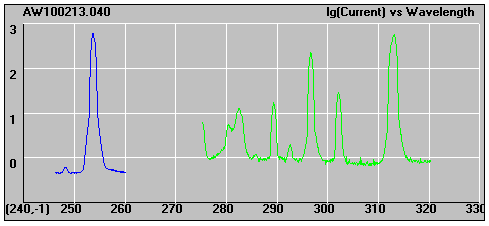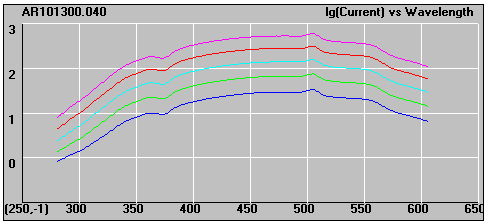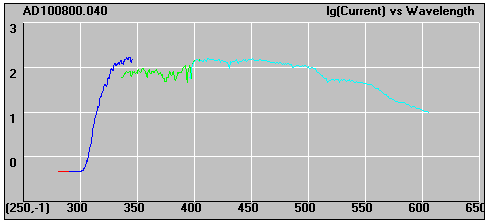Antarctic UV Network Instrument Calibrations/Characterizations
Absolute Calibration Scans

Absolute Calibration Scans are performed on a tentative bi-weekly schedule (weather dependant) using several external 200 Watt Halogen Lamps. The external Halogen lamps are tied to the NIST Irradiance Scale. Absolute scans are used to calibrate the daily responsivity scans.
Currently there are two versions of the Absolute Scan, Version 1.0 and the preferred Version 2.0. The properties of the items contained in the Absolute Scans are shown in the two tables below. Note, both versions of the Absolute Scans incorporate scans from both the external 200W Halogen reference lamps and the internal 45W Halogen Lamp.


Multi-Wavelength Calibration Scans

Multi-Wavelength Calibration Scans use the instruments internal 40 Watt Mercury (HG) Lamp and are performed once per day. Lines in Mercury spectrum are used to monitor the wavelength registration of the SUV-100. Multi-Wavelength scans are paired with Data Scans, preferably from the same day. If the Wavelength scan for a given day is unusable, Data scans may be paired with Wavelength scans from a previous or following day.
Properties of the eight items defined in the Multi-Wavelength Calibration Scan (also referred to as a Regular Wavelength Scan) are shown in the table below:

Short-Wavelength Calibration Scans

Short-Wavelength Calibration Scans use the instruments internal 40 Watt Mercury (HG) Lamp and are performed once per day, and also in between lamp changes during Absolute Calibration Scans. Lines in Mercury spectrum are used to monitor the wavelength registration of the SUV-100.
Properties of the two items defined in the Multi-Wavelength Calibration Scan (also referred to as a Regular Wavelength Scan) are shown in the table below:

Responsivity Calibration Scans

Responsivity Scans use the instruments internal 40 Watt Halogen Lamp and are performed once per day. Responsivity scans are paired with Data Scans, preferably from the same day. If the responsivity scan for a given day is unusable, Data scans may be paired with responsivity scans from a previous or following day.
The number of items included in a response scan will vary thoughout the year. Response scans will only include items where the high voltage matched the voltage used in one or more atmospheric data scans. During the polar night, when the sun in continually below the horizon, response scans will only include item 6. See Atmospheric Data Scans for more information about the relationship between solar elevation and PMT high voltage.
Properties of the six items defined in the Response Calibration Scan (also referred to as an Assembled Response Scan) are shown in the table below:

Atmospheric Data Scans

Data Scans are run every fifteen minutes when the sun is above the horizon. A given scan will start at 0, 15, 30, or 45 minutes past the hour and collect data for about ~13.5 minutes. There are seven different sampling methods, which method used, depends on the elevation of the sun.
Properties of the seven tables used to defined scan parameters for Data Scans are shown in the tables below:

Dark Scans
Dark Scans can be run manually to check the Photomultiplier Tube's (PMT) dark current. These scans are run when the shutter is closed. They can be used to help determine if the shutter is operating correctly.
Properties of ten items used during a Dark Scan are shown in the table below:

External Wavelength Scans
External Wavelength Scans use an external Mercury lamp (Hg) test apparatus that attaches to the external diffuser of the SUV-100. These scans are performed during annual maintenance visits. The principal is identical to the Multi-Wavelength scan, except the light-path includes the instrument's diffuser. The PMT voltages applied during the 8 items are slightly different from those used for Multi-Wavelength Scan.
Properties of eight items used during a External Wavelength Scan are shown in the table below:

User-Defined Scans
User-Defined Scan, as the name implies can be configured by the user for some specific measurement task.
Properties of ten items used during a User-Defined Scan are shown in the table below:


